Current trend
The GBP/USD pair is showing upward momentum around 1.2927, recouping losses from the previous session when the US dollar strengthened following the victory of Republican candidate Donald Trump in the presidential election. He previously announced a tougher foreign trade policy with a sharp increase in import duties on goods from the EU and China, which in turn will lead to the US Federal Reserve becoming less active in reducing borrowing costs, especially in comparison with the European Central Bank (ECB) or the Bank of England, where the pace of economic slowdown is noticeably higher.
The focus of investors' attention today is on meetings of the American and the British regulators. Both agencies are expected to adjust interest rates by –25 basis points to 4.75%. The UK rate currently stands at 5.00%, following a 25-basis-point cut in August for the first time since 2020. Since then, data has shown that the country's Consumer Price Index fell to 1.7% in September, its lowest since April 2021, primarily driven by a sharp drop in petrol and airfare prices. Before the budget was passed, cuts were seen as almost inevitable — with a second step in December — but the larger-than-expected scale of planned government spending and borrowing revealed last week prompted analysts to change their forecasts. In addition, the slowdown in business activity in October, revealed in today's final S&P Global UK survey, suggests that budget uncertainty has forced companies to pause spending and investment, with the Composite PMI falling from 52.5 points to 51.8 points, the lowest since November last year.
The data on business activity in the construction sector also put additional pressure on the British currency the day before: in October, the index fell from 57.2 points to 54.3 points, with expectations of 56.0 points. At the same time, the day before, investors noted the growth of the Services PMI from 51.8 points to 52.0 points. Meanwhile, Retail Sales from the British Retail Consortium (BRC) slowed sharply in October from 1.7% to 0.3%, while experts expected 1.4%.
Support and resistance
Bollinger Bands on the daily chart demonstrate a moderate decrease. The price range is expanding slightly but it fails to conform to the surge of trading activity at the moment. MACD is declining keeping a weak sell signal (located below the signal line). Stochastic is showing similar dynamics having reversed downwards near the center of its area.
Resistance levels: 1.2948, 1.3000, 1.3050, 1.3100.
Support levels: 1.2900, 1.2860, 1.2817, 1.2776.


Trading tips
Long positions can be opened after a breakout of 1.2948 with the target of 1.3050. Stop-loss — 1.2900. Implementation time: 2-3 days.
A rebound from 1.2948 as from resistance, followed by a breakdown of 1.2900 may become a signal for opening of new short positions with the target at 1.2817. Stop-loss — 1.2948.





Hot
No comment on record. Start new comment.